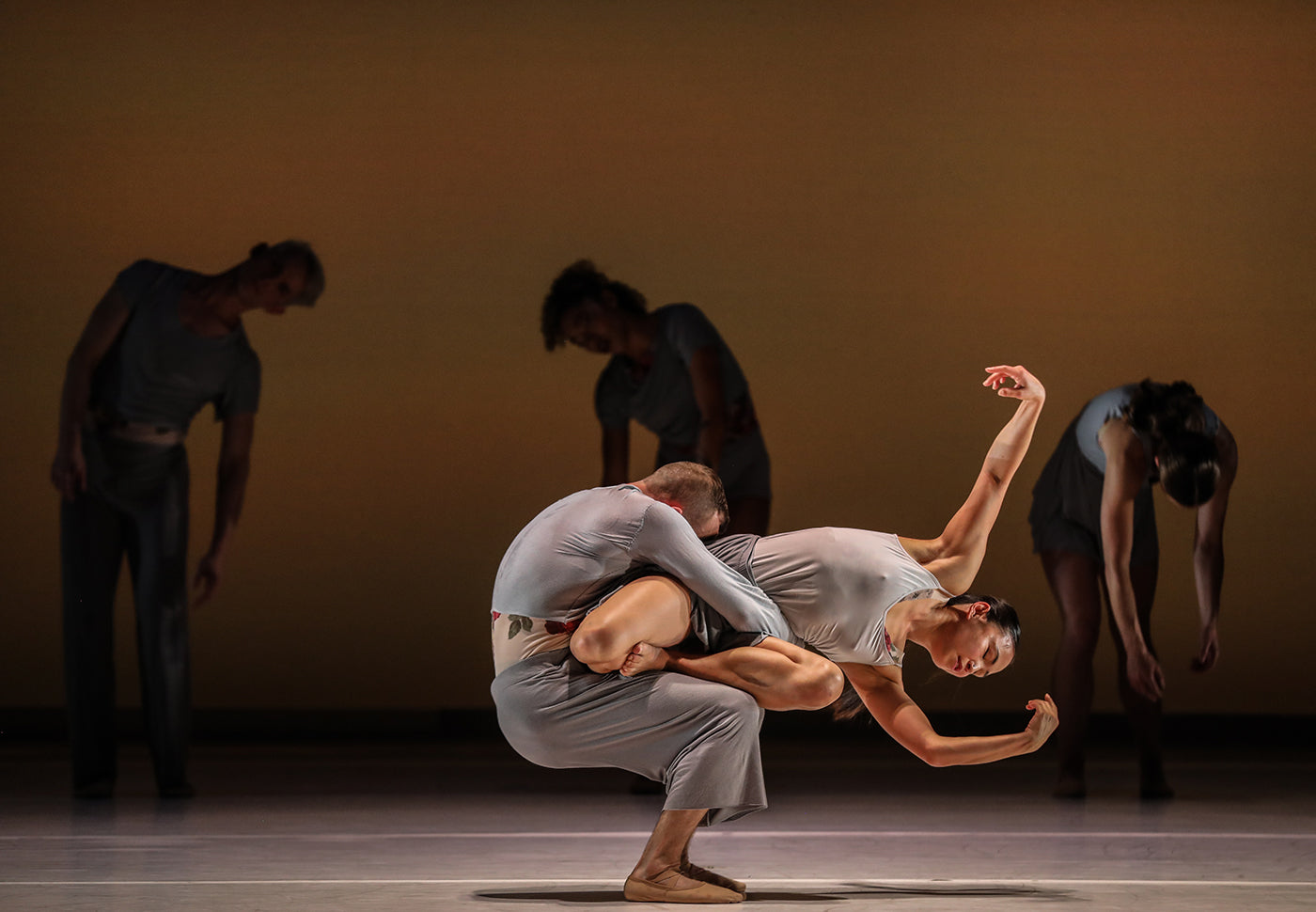Now, choreographer Wayne McGregor, composer Jamie xx, and visual artist Olafur Eliasson have transformed that story once again by developing Tree of Codes into a ballet. The performance debuted at the Manchester International Festival this past July and made its U.S. premiere at New York City’s Park Avenue Armory on September 14.
“Tree of Codes” offers a mesmerizing display of movement, backdrops, and music. But, just as Foer’s book is hailed as a work of art more than as a novel, so this ballet is more a feat of design than of dance.
The work opens with a whisper, as dancers mount the platform stage in darkness. They wear baubles of light, but their limbs, their torsos, and their faces are cast in the shadows. They likely glide across the stage in a series of sashays and tumble gracefully, but it’s tough to tell: with only the illuminated parts of their costumes visible, they seem to flit like fireflies. As the piece progresses, the dancers arrange themselves to create clusters of light or constellations, and the accompanying music—a wistful hum of lines like “you go again from the darkened stars”—suggests that our story begins just after midnight, when nature comes out to play.
The subsequent scene is more colorful, but still coy: only the dancers’ arms are visible. They have, it seems, slipped these limbs into large sleeves that look like phonograph horns. As they flick their wrists, they bring to life Foer’s “thousand kaleidoscopic possibilities.” And Jamie xx, once again, sets the mood—this time, with a chorus that evokes whale songs.
In these scenes, “Tree of Codes” establishes itself as a work of illusion. But as the evening progresses, the work exhausts its whimsy. Foer, as noted, finds "an awkward undecided direction, a shaky and uncertain line of indefinite basic sadness” in Schulz’s work. And the team behind the ballet try to bring this narrative to life. In one pas de deux, a modelesque dancer melds herself to her male counterpart. As they swan dive into each other, they dance out what could be a funeral dirge or a mating ritual. Behind them, another couple dances behind a plexiglass backdrop, and the four dancers mirror each other’s movements. Their shadows overlap.
I could not keep my eyes off of the first female dancer. Her flexibility and reach were extraordinary, and she moved like liquid silver. She was light, crisp, and clean. But despite her plasticity, I wanted her to dance with more dynamite.
This trend continues over the course of the performance: “Tree of Codes” plants dancers with beautiful bodies on stage, but presents them as design patterns, not people. In another pas de deux, a couple tussles as a third woman appears on stage and tempts the man away from his partner. This triangle provides an opportunity to heighten the tension; instead, the two women befriend one another, ultimately holding hands as they shuffle across the stage. This resolution makes narrative sense—it reveals that the couple is better matched with other love interests. Still, this scene ends swiftly, almost prematurely, and I wonder why this—or really any—particular moment was included in the ballet, beyond its being pleasing to watch.
Despite these potential missteps, the work’s design consistently dazzles. The dancers make their way through the evening in a wardrobe that includes mustard yellow briefs, blousy green tops, and maroon unitards. Paired with this modular dress code is a set of geometric glass backdrops; when layered, they filter the dancers' movements and, like a house of mirrors, multiply their movements. At times, though, these design elements are overpowering, particularly when they implicate the audience. A spotlight, for one, pans over the audience throughout the evening, capturing a few members’ faces at a time and reflecting their expressions onto one of the stage’s plexiglass backdrops. This feature is, perhaps, meant to connect the audience with the dancers, to make us feel included in the wonder of the evening; instead, I feel spied on, one spotlight away from becoming the center of attention, if only temporarily. In that discomfort, I had trouble immersing myself in what was on stage.
So, what of Foer’s “small quick heartbeat, delicate and impatient”? Once again, the ballet seeks to build off of this type of repurposed sentence—most notably, in its finale.
To this point, the choreography could be faulted for inching along; although the transitions from one sequence to another sometimes seem rushed, the dancers move within each pieces as if they are fixed in rewind or in a time warp: the may move swiftly, but they never move forward.
The ballet's finale, though, throttles ahead, and the dancers, who are staggered across the stage, seem even more out of touch with each other. As they thrust their hips and throw out their arms, they are out of sync. The spotlight continues to roam the audience, but it seems confused. And two huge circles that are cut out of the glass-paned backdrop begin to spin on an axis, leaving the audience with an unfiltered glimpse at those who dance behind the colored panes.
In a 2010 New York Times interview, Foer stressed the importance of design for literature: “Why wouldn’t—how couldn’t—an author care about how his or her books look?” Sure, but a stunning design does not compensate for a lackluster story, and a shoddy cover won’t ruin the experience of reading a stellar book.
At the Armory, the “Tree of Codes” team takes extensive care to develop the look of the ballet. But when the performance’s last chord concludes, the dancers depart, and the colored glass recedes, what’s left to feel?









comments